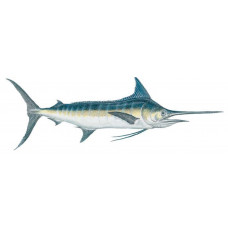Latin name
Makaira nigricans and Makaira mazara
Other names
Atlantic blue marlin, Pacific blue marlin, Cuban black marlin; French: espadon, makaire bleu; Japanese: makajiki, nishikuro; Portuguese: agulhao preto; Spanish: abanco, aguja azul, castero, marlín azul.
Identification
The pectoral fins of the blue marlin are never rigid, even after death, and can be fully folded over the sides. The dorsal fin is tall and pointed (rather than rounded) at the front, and its greatest height is less than its greatest body depth. The anal fin is relatively large and also pointed. Young specimens may not have all these characteristics, but a peculiar system of lateral lines is usually visible in small specimens. In adults, it is rarely visible unless the scales or skin are removed. The lateral line of the Pacific blue marlin is a series of large chain-like loops along the sides. The lateral line of all Atlantic blue marlin is a network, more complex than that of Pacific marlin specimens. The belly is just in front of the anal fin, as in all other fish except spearfish, and the upper jaw is elongated in the shape of a spear. The back is cobalt blue, while the sides and belly are silvery white. There may be light blue or lavender vertical stripes on the flanks, but these normally disappear soon after death and are never as obvious as those of the striped marlin. There are no spots on the fins. The little blue marlin is similar to the white marlin, but the blue marlin has a sharper dorsal fin at the anterior end and sharper tips on the pectoral and anal fins, and it has no spots on the dorsal fin.
Distribution
This pelagic, migratory species inhabits tropical and warm temperate ocean waters. It occurs in the Atlantic Ocean from 45°N to 35°S, and in the Pacific Ocean from 48°N to 48°S. It is less abundant in the eastern parts of both oceans. In the northern Gulf of Mexico, its movements are associated with the continuation of the Caribbean Current. Seasonal concentrations are observed in the southwestern Atlantic (5° to 30° south latitude) from January to April, in the northwestern Atlantic (10° to 35° north latitude) from June to October, and in the western and central North Pacific (2° to 24° north latitude) from May to October.
Habitat
These fish live in the warm blue waters of the shelf, usually in considerable depths and where there are underwater structures (e.g., canyons, cliffs, ridges, seamounts) and currents that attract large numbers of bait fish.
Size
The blue marlin is the largest marlin in the Atlantic Ocean. Elsewhere, it can grow to a size equal to or greater than that of the black marlin. The blue marlin is the largest of the representatives of the family Istiophoridae. On average, it grows larger in the Pacific Ocean, where a few decades ago a single specimen caught commercially weighed 2,200 pounds and a specimen caught by an angler weighed 1,800 pounds. The world record for the Atlantic blues caught on all tackle is 1,402 pounds, caught in 1992 in Vitoria, Brazil. The world record for Pacific blues caught on all tackle is 1,376 pounds, caught in 1982 in Kona, Hawaii. All of these giants are female, as male blue marlin rarely weigh more than 300 pounds. Most blue marlin caught by anglers are between 150 and 400 pounds. Blue marlin are believed to live over 15 years, although fish over 10 years old are rare.
Life history and Behavior
The life history of the blue marlin is little known. The full extent of its oceanic wanderings is unknown, as well as its spawning activity in the open sea. They are usually solitary.
Food and feeding habits
Blue marlin feed on squid and pelagic fish, including tuna and mackerel, as well as dolphins. They eat just about anything, depending on availability. Because they require large quantities of food, they are not present where prey is limited.
Reproduction
No information
| Classification | |
| Phylum | Chordata |
| Class | Actinopterygii |
| Squad | Istiophoriformes |
| Family | Istiophoridae |
| Genus | Makaira |
| Species | M. nigricans |
| Features | |
| Conservation status | Vulnerable |
| Habitat | Pelagic |
| Life span, years | 27 |
| Maximum body weight, kg | 636 |
| Maximum length, cm | 500 |
| Sailing speed, m/s | 20.83 |
| Threat to people | Edible |
| Way of eating | Predator |



